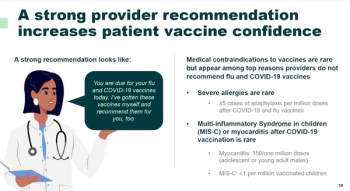
Early oseltamivir treatment associated with 30 percent decrease in mortality for some flu strains
A new report links early treatment of influenza A/H3N2 with the drug to a 30% decrease in mortality.
A new study reports that early treatment of influenza with oseltamivir can save lives, depending on the circulating virus.
“Our finding is completely novel in that the efficacy of oseltamivir appears to depend on influenza type and subtype,” said lead author Theodore Lytras, MD, PhD, an epidemiologist at the Hellenic Centre for Disease Control and Prevention. “Moreover, almost all research on oseltamivir to date has focused on patients with influenza A(H1N1)pdm09, the pandemic strain from 2009. Importantly, our study found no efficacy of oseltamivir in these patients or in influenza B patients.”
Some flu seasons are deadlier than others, and last year was one of those. In 2017-18, the influenza A/H3N2 was the predominant virus-and is also one of the strains that is particularly dangerous for high-risk individuals and seniors.
“Our finding of lower mortality with early oseltamivir among critically ill A(H3N2) patients was both unexpected and immensely important. This influenza subtype causes significant morbidity and mortality especially among the elderly, and is often poorly covered by the seasonal influenza vaccine,” Lytras said. “Again, this needs to be confirmed in further research, but it is already too important to ignore. And although it is evidence to support current recommendations, it is different from past such evidence that have focused on A(H1N1)pdm09.”
The study investigated the cases of 1,330 patients treated for influenza in intensive care units in Greece over eight flu seasons. All of the patients in the study were adults, on mechanical ventilation, and treated only with oseltamivir, according to the report.
Researchers found that 46.8 percent of the patients in the study died during treatment, but that those with influenza type A/H3N2 has significantly lower rates of mortality with early oseltamivir treatment. For this study, early onset treatment was defined as treatment with oseltamivir within 48 hours of symptom onset, according to the report.
Patients with influenza A/H3N2 benefitted specifically from early oseltamivir treatment, according to the study, with 33.7 percent mortality in cases with early oseltamivir treatment compared to 48.4 percent in those who received the antiviral later in the disease process. Early oseltamivir treatment was also associated with shorter ICU stays in patients with influenza A/H3N2-12 days versus 15 days for those treated later in the disease process. The study, however, did not find any improvements in mortality for patients with influenza B or A/H1N1.
Lytras said the study demonstrates the importance of early, targeted flu treatment.
“Clinicians need to promptly treat with oseltamivir high-risk or severely ill patients with suspected influenza, especially when subtype A(H3N2) is in circulation,” Lytras said. “The potential benefit-30% lower mortality among A(H3N2) patients-is too much to ignore, even though our study finding will need to be replicated in further research. This is in line with current guidelines about the use of oseltamivir.”
Lytras said he hopes the study will result in further research on targeted flu treatment and the efficacy of oseltamivir for treatment in certain strains of influenza.
“Hopefully this will happen quickly,” he says. “Until it does, we hope that clinicians adhere to current recommendations about promptly treating with oseltamivir high-risk or severely ill patients with suspected influenza. And if our study findings are confirmed, this will result in quite a lot of lives saved.”
Newsletter
Stay informed and empowered with Medical Economics enewsletter, delivering expert insights, financial strategies, practice management tips and technology trends — tailored for today’s physicians.














